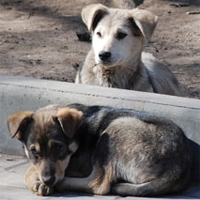It is without question that better animal protection laws are needed throughout the world. Every country has different definitions of humane care, and even the U.S. is still a work in progress to create a more humane space for the cats and dogs we share our nation with.
That said, it’s hard to imagine being an animal lover and living in Romania, where the President has just made a national declaration to aim to kill as many as 200,000 stray dogs in the city of Bucharest. A brutal mauling near a playground earlier in the week left a 4-year-old boy dead and his 6-year-old companion injured, spurring the resolution announced by independent President Traian Basescu on September 3.
More than 1,100 people were bit by stray dogs in the country’s capital in just the first quarter of 2013, suggesting the stray problem is not limited to this tragic incident. Simultaneously, it reminds us animal welfare advocates have their hands full trying to manage the staggering number of strays without compromising public safety.
The stray dog problem is largely believed to be a result of the industrialization of Romania in the late 20th century. As farmers moved to urban areas, their dogs came along, but were turned loose and began breeding prolifically thanks to intermittent feeding by residents, availability of trash for scavenging, and close living quarters.
The proposed solution does not outline how exactly the animals will be rounded up and killed, but advocates voice concern that the animals will be exterminated with poison or firearms.
The situation continued for decades before a series of animal welfare laws were enacted making dogfighting illegal, requiring pet owners provide their animals with food and shelter, and that animal shelters were not allowed to euthanize “healthy” animals. While the latter version of the popular “no-kill” notion may sound life-saving, it backfired; and as a result, compounding the canine welfare situation in Bucharest.
Animal shelters in Romania are routinely full, and not just with recent arrivals. Some facilities house animals for years without rehabilitation, training, or appropriate healthcare, and dogs languish in sorrow and squalor in the group kennels, while dogs in the street can be picked up but cannot be allowed into the shelters for lack of space.
While merciless mass killing of dogs in the streets can hardly be called a humane solution, those who created this problem by essentially filling the shelters and then closing the doors with the “no-kill” resolution of 2008 cannot turn away from the problem they, in part, created. You cannot simply stop euthanizing animals in shelters without first creating a community of compassion that wishes to see a long-term resolution to pet overpopulation.
Active trap-neuter-return programs are implemented in the country with the goal of reducing the overall numbers of animals on the streets, and as a result, improving public safety. However, in a problem similar to that in the United States, no matter how powerful the animal protection laws, the laws remain impotent without an enforcement agency.
The problem in Bucharest is not unlike the problem America has in Detroit or Houston with stray dogs. The only difference is we have not yet had a president with the trap-and-kill philosophy of President Basescu.
So, before it comes to that, what will you do to make change for our dogs and make sure we do not come to the point that Bucharest already has?









